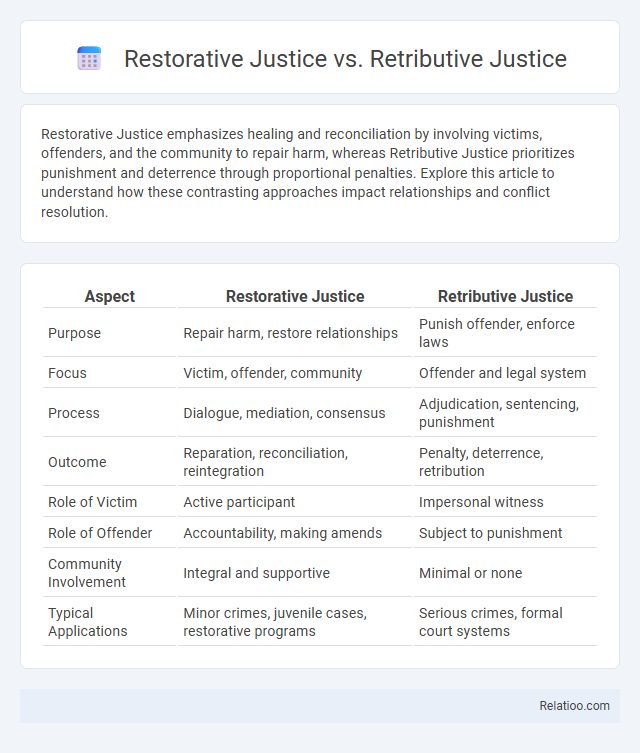Restorative Justice emphasizes healing and reconciliation by involving victims, offenders, and the community to repair harm, whereas Retributive Justice prioritizes punishment and deterrence through proportional penalties. Explore this article to understand how these contrasting approaches impact relationships and conflict resolution.
Table of Comparison
| Aspect | Restorative Justice | Retributive Justice |
|---|---|---|
| Purpose | Repair harm, restore relationships | Punish offender, enforce laws |
| Focus | Victim, offender, community | Offender and legal system |
| Process | Dialogue, mediation, consensus | Adjudication, sentencing, punishment |
| Outcome | Reparation, reconciliation, reintegration | Penalty, deterrence, retribution |
| Role of Victim | Active participant | Impersonal witness |
| Role of Offender | Accountability, making amends | Subject to punishment |
| Community Involvement | Integral and supportive | Minimal or none |
| Typical Applications | Minor crimes, juvenile cases, restorative programs | Serious crimes, formal court systems |
Introduction to Restorative and Retributive Justice
Restorative Justice centers on repairing harm through dialogue and mutual agreement between the victim and offender, emphasizing accountability and healing over punishment. Retributive Justice prioritizes punishment proportional to the offense, focusing on moral culpability and societal deterrence. Understanding these frameworks helps you navigate approaches to justice that either restore relationships or enforce legal consequences.
Defining Restorative Justice: Principles and Goals
Restorative justice centers on repairing harm caused by criminal behavior through inclusive dialogue involving victims, offenders, and the community, emphasizing accountability, healing, and restitution. Its principles prioritize collaboration, respect, and the active participation of all parties to restore relationships and promote social harmony. Understanding restorative justice empowers you to seek resolutions that foster rehabilitation and community reintegration rather than focusing solely on punishment.
Understanding Retributive Justice: Core Concepts
Retributive justice centers on the principle that punishment should be proportionate to the offense, emphasizing accountability and deterrence through legal consequences. This approach prioritizes the rights of victims and society by ensuring offenders face consequences that reflect the severity of their crimes. Understanding this core concept helps you grasp the fundamental differences between retributive justice, restorative justice, and reconciliation in addressing harm and conflict.
Historical Development of Justice Systems
The historical development of justice systems traces a progression from retributive justice, centered on punishment and deterrence, toward restorative justice, which emphasizes healing and repairing harm through community involvement. Reconciliation emerges as a distinct yet complementary approach, often employed in post-conflict societies to restore relationships and promote social cohesion. Your understanding of these justice models highlights a shift from punitive measures to processes that prioritize repair, accountability, and collective restoration.
Key Differences Between Restorative and Retributive Justice
Restorative justice emphasizes repairing harm by involving victims, offenders, and the community in dialogue, fostering accountability and healing, whereas retributive justice focuses on punishment proportional to the offense, aiming to uphold legal order and deter wrongdoing. Restorative justice seeks to restore relationships and promote reconciliation, contrasting with the retributive approach that centers on assigning blame and administering penalties. Your understanding of these key differences can inform approaches to justice that prioritize either healing or punishment based on the context.
Stakeholder Roles in Each Justice Model
Restorative justice centers on active participation from victims, offenders, and community members working collaboratively to repair harm and restore relationships. Retributive justice emphasizes judicial authorities and legal systems imposing punishments based on established laws to ensure accountability and deterrence. Reconciliation involves stakeholders such as mediators, victims, and offenders engaging in dialogue and emotional healing processes aimed at rebuilding trust and fostering long-term peace.
Impact on Victims and Offenders
Restorative justice prioritizes healing by involving victims and offenders in a dialogue that seeks repair and collaboration, significantly improving victims' emotional recovery and offender accountability. Retributive justice emphasizes punishment as a deterrent, often leaving victims with a sense of closure but limited emotional restitution, while offenders may experience alienation and stigma. Reconciliation fosters mutual understanding and forgiveness, promoting long-term emotional healing and social reintegration for both parties, though it requires willingness and trust to be effective.
Effectiveness in Reducing Recidivism
Restorative justice emphasizes repairing harm by involving victims, offenders, and the community, showing higher effectiveness in reducing recidivism compared to retributive justice, which focuses on punishment and often neglects rehabilitation aspects. Reconciliation seeks mutual understanding and healing but may lack structured mechanisms to prevent repeat offenses, rendering its impact less quantifiable. Your engagement in restorative processes can promote accountability and lower the likelihood of reoffending, making it a valuable approach for lasting change.
Global Examples and Case Studies
Restorative justice emphasizes repairing harm through dialogue and community involvement, as demonstrated by New Zealand's use of Maori-led processes to reconcile offenders and victims, reducing recidivism rates significantly. Retributive justice, prevalent in the United States, relies on proportional punishment and incarceration to uphold legal order, exemplified by strict sentencing laws despite critiques of systemic inequalities. Reconciliation efforts in South Africa's Truth and Reconciliation Commission highlight the power of acknowledgment, forgiveness, and restorative narratives in healing post-apartheid divisions and promoting long-term social cohesion.
Future Trends in Justice Approaches
Future trends in justice approaches emphasize the integration of restorative justice principles, focusing on healing and community involvement rather than solely punishment. Advances in data analytics and AI are enhancing personalized justice strategies, enabling Your involvement in mediated solutions that prioritize reconciliation over retributive measures. Emerging models seek to balance accountability with empathy, promoting sustainable societal harmony through collaborative decision-making processes.

Infographic: Restorative Justice vs Retributive Justice
 relatioo.com
relatioo.com